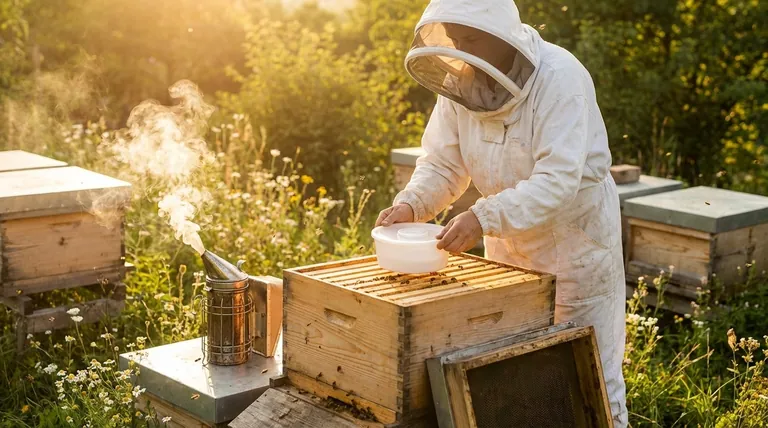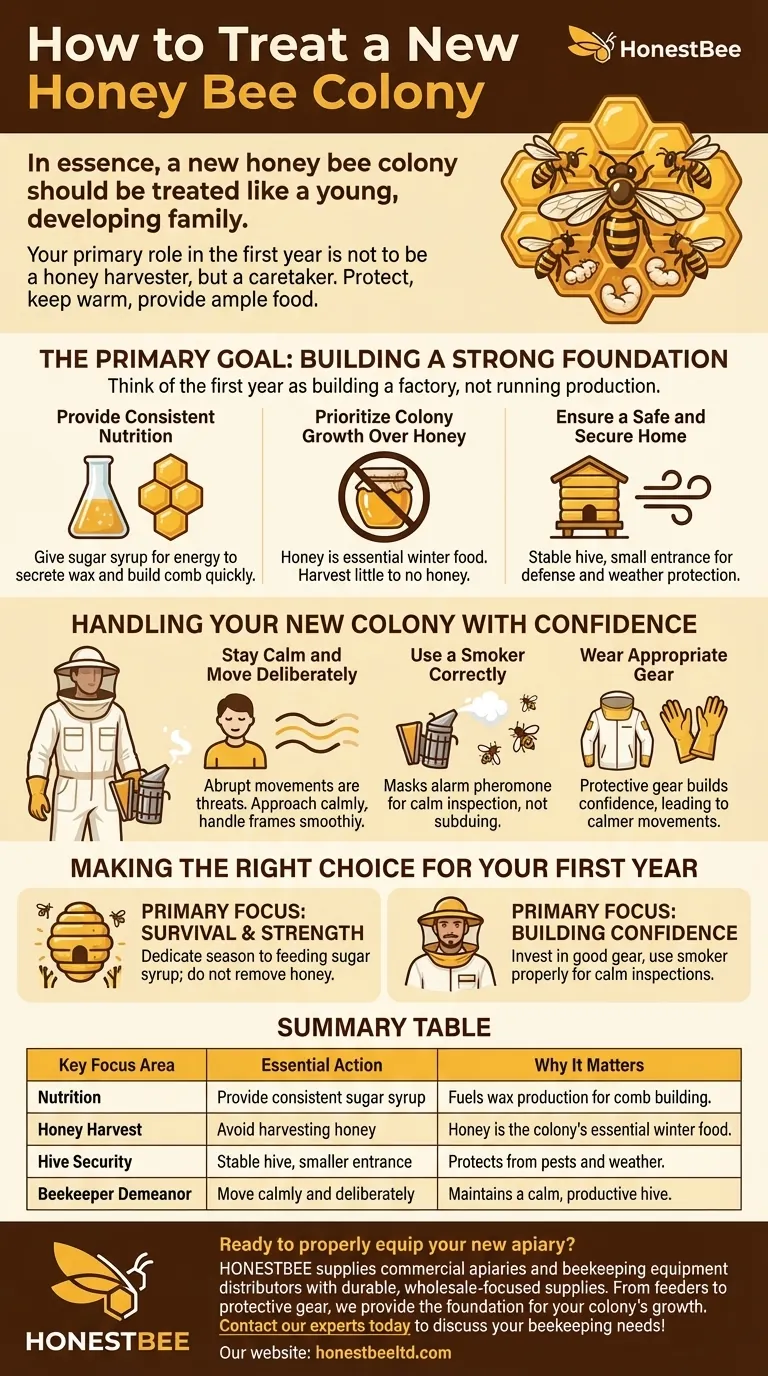In essence, a new honey bee colony should be treated like a young, developing family. Your primary role in the first year is not to be a honey harvester, but a caretaker. You must protect it from danger, keep it warm, and provide ample food to fuel its growth and ensure its survival through the first winter.
The central mindset for a new beekeeper is to shift focus from production to establishment. Your goal in the first year is not to harvest honey, but to invest resources—namely food and protection—to build a strong, self-sufficient colony that will be productive for years to come.

The Primary Goal: Building a Strong Foundation
Think of the first year as building a factory, not running production. The bees are drawing comb (the machinery), raising brood (the workforce), and storing initial resources. Your job is to provide the raw materials they need to complete this critical construction phase.
Provide Consistent Nutrition
A new colony has an immense amount of work to do and very few "forager" bees to do it. They must build their entire wax comb infrastructure from scratch.
Providing a consistent supply of sugar syrup gives them the carbohydrate energy needed to secrete wax and build their home quickly, without having to expend precious resources foraging.
Prioritize Colony Growth Over Honey
The honey a new colony produces in its first year is not a surplus; it is their essential food store for the upcoming winter.
Taking any of this honey can severely compromise their ability to survive. It is perfectly normal, and expected, that you will harvest little to no honey from a first-year colony.
Ensure a Safe and Secure Home
Like any young animal, a new colony is vulnerable. Ensure the hive is stable and protected from strong winds or direct, harsh weather.
A smaller entrance can also help them defend their new home more easily from robbing bees or other pests while their population is still small.
Handling Your New Colony with Confidence
Your interactions with the bees set the tone for the hive. A calm, deliberate approach ensures the safety of both you and your colony, allowing them to focus on their work.
Stay Calm and Move Deliberately
Honey bees often mirror the energy of the beekeeper. Abrupt movements and nervousness can be perceived as a threat.
Approach the hive calmly and handle the frames with smooth, steady motions to keep the colony's defensive response low.
Use a Smoker Correctly
A smoker is not for subduing bees; it's for communication. A few gentle puffs of cool, white smoke at the entrance and under the lid masks the alarm pheromone bees release.
This interrupts their defensive communication, allowing you to perform your inspection on a much calmer colony.
Wear Appropriate Gear
Protective gear is a tool for your own confidence. When you aren't worried about being stung, you are more likely to move calmly and deliberately, which in turn keeps the bees calmer.
As you gain experience and learn the temperament of your specific colony, you can adjust your level of protection.
Making the Right Choice for Your First Year
Your actions in the first year directly determine the colony's long-term health and future productivity.
- If your primary focus is colony survival and strength: Dedicate the entire first season to feeding the bees as much sugar syrup as they will take and do not remove any honey.
- If your primary focus is building confidence as a beekeeper: Invest in a good suit and use your smoker properly to ensure hive inspections are calm, positive learning experiences.
By nurturing your new colony through its first year, you are making a direct investment in its future success and abundance.
Summary Table:
| Key Focus Area | Essential Action | Why It Matters |
|---|---|---|
| Nutrition | Provide consistent sugar syrup feeding. | Fuels wax production for comb building. |
| Honey Harvest | Avoid harvesting honey the first year. | Honey is the colony's essential winter food store. |
| Hive Security | Ensure a stable hive with a smaller entrance. | Protects the vulnerable colony from pests and weather. |
| Beekeeper Demeanor | Move calmly and deliberately during inspections. | A calm beekeeper helps maintain a calm, productive hive. |
Ready to properly equip your new apiary? HONESTBEE supplies commercial apiaries and beekeeping equipment distributors with the durable, wholesale-focused supplies needed for a successful first year and beyond. From feeders to protective gear, we provide the foundation for your colony's growth. Contact our experts today to discuss your beekeeping needs!
Visual Guide

Related Products
- Rapid Bee Feeder White Plastic 2L Round Top Feeder for 8 or 10-Frame Bee Hives
- Professional Hive Top Bee Feeder for Beekeeping
- Classic Boardman Entrance Bee Feeder Hive Front Feeding Solution
- HONESTBEE Entrance Bee Feeder Professional Hive Nutrition Solution for Beekeeping
- Professional Hive Front Entrance Bee Feeder
People Also Ask
- What is the best thing to feed bees? A Guide to Supplemental Feeding for a Thriving Hive
- How much honey does a strong hive need to survive winter? Ensure Your Colony's Survival (60-80 lbs)
- Do beekeepers leave honey for bees? The Essential Guide to Sustainable Hive Management
- How do you set up and use a top feeder for bees? A Step-by-Step Guide for Safe Feeding
- Can you dilute honey and feed it to the bees? Understand the Critical Risks and Safe Practices



















